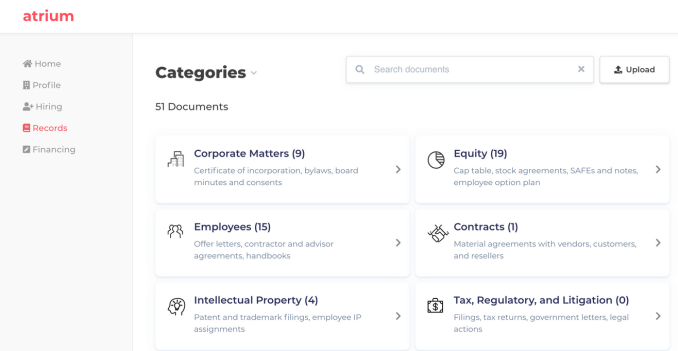$75M legal startup Atrium shuts down, lays off 100
Justin Kan’s hybrid legal software and law firm startup Atrium is shutting down today after failing to figure out how to deliver better efficiency than a traditional law firm, the CEO tells TechCrunch exclusively. The startup has now laid off all its employees, which totaled just over 100. It will return some of its $75.5 million in funding to investors, including Series B lead Andreessen Horowitz. The separate Atrium law firm will continue to operate.
“I’m really grateful to the customers and the team members who came along with me and our investors. It’s unfortunate that this wasn’t the outcome that we wanted but we’re thankful to everyone that came with us on the journey” said Kan. He’d previously founded Justin.tv which pivoted to become Twitch and later sold to Amazon for $970 million. “We decided to call it and wind down the startup operations. There will be some capital returned to investors post wind-down” Kan told me.

Atrium had attempted a pivot back in January, laying off its in-house lawyers to become a more pure software startup with better margins. Some of its lawyers formed a separate standalone legal firm and took on former Atrium clients. But Kan tells me that it was tough to regain momentum coming out of that change, which some Atrium customers tell me felt chaotic and left them unsure of their legal representation.
More layoffs quietly ensued as divisions connected to those lawyers were eliminated. But trying to build software for third-party lawyers, many of which have entrenched processes and older leadership, proved difficult. The streamlined workflows may not have seemed worth the thrash of adopting new technology.
“If you look at our original business model with the veritcalized law firm, a lot of these companies that have this kind of full stack model are not going to survive” Kan explained. “A lot of these companies, Atrium included, did not figure out how to make a dent in operational efficiency.”
Disrupting Law Firms Proves Difficult
Founded in 2017, Atrium built software for startups to navigate fundraising, hiring, acquisition deals, and collaboration with their legal team. Atrium also offered in-house lawyers that could provide counsel and best practices in these matters. The idea was that the collaboration software would make its lawyers more efficient than a traditional law firm so they could get work done faster, translating to savings for clients and Atrium.

Atrium’s software included Records, a Dropbox-esque system for keeping track of legal documents, and Hiring, which instantly generated employment offer letters based on details punched into a form while keeping track of signatures. The startup hoped it could prevent clients and lawyers from wasting time digging through email chains or missing a sign-off that could put them in legal jeopardy.
The company tried to generate client leads by hosting fundraising workshops for startups, starring Kan and his stories from growing Twitch. A charismatic leader with a near-billion dollar exit under his belt, investors and founders alike were quick to buy into Kan’s vision and advice. Startups saw Atrium as an ally with industry expertise that could help them avoid dirty term sheets or botched hires.

But keeping a large squad of lawyers on staff proved costly. Atrium priced packages of its software and legal assistance under subscriptions, with momentous deals like acquisitions incurring add-on fees. The model relied less on milking clients with steep hourly rates measured down to six-minute increments like most law firms.
Yet eliminating the busy work for lawyers through its software didn’t materialize into bountiful profits. The pivot saught to create a professional services network where Atrium could route clients to attorneys. The layoffs had shaken faith in the startup as clients demanded stability lest they be caught without counsel at a tough time
Rather than trudge on, Kan decided to fold the company. The standalone Atrium law firm will continue to operate under partners Michel Narganes and Matthew Melville, but the startup developing legal software is done.
Atrium’s implosion could send ripples through the legaltech scene, and push other entrepreneurs to start with a more focused software-only approach.
Powered by WPeMatico
Stack Overflow expands its Teams service with new integrations
Most developers think of Stack Overflow as a question and answer site for their programming questions. But over the last few years, the company has also built a successful business in its Stack Overflow for Teams product, which essentially offers companies a private version of its Q&A product. Indeed, the Teams product now brings in a significant amount of revenue for the company and the new executive team at Stack Overflow is betting that it can help the company grow rapidly in the years to come.
To make Teams even more attractive to businesses, the company today launched a number of new integrations with Jira (Enterprise and Business), GitHub (Enterprise and Business) and Microsoft Teams (Enterprise). These join existing integrations with Slack, Okta and the Business tier of Microsoft Teams.
“I think the integrations that we have been building are reflective of that developer workflow and all of the number of tools that someone who is building and leveraging technology has to interact with,” Stack Overflow Chief Product Officer Teresa Dietrich told me. “When we think about integrations, we think about the vertical right, and I think that ‘developer workflow’ is one of those industry verticals that we’re thinking about. ChatOps is obviously another one, as you can see from our Slack and Teams integration. And the JIRA and GitHub [integrations] that we’re building are really at the core of a developer workflow.”
Current Stack Overflow for Teams customers include the likes of Microsoft, Expensify and Wix. As the company noted, 65 percent of its existing Teams customers use GitHub, so it’s no surprise that it is building out this integration.
Powered by WPeMatico
Sensel raises a $28M Series A to bring pressure sensing tech to more mobile devices
I was honestly surprised to find out from Sensel that the company is only just recently raising its Series A. The Sunnyvale-based hardware startup has been around since 2013, bringing its first product, the modular music and computing Morph peripheral, to market a few years back.
Over the past few years, however, the company’s been undergoing a bit of a slow motion pivot. As fascinating as the Morph has been, the multiple touch input device has proven to be something more akin to a proof of concept for Sensel. I’ve met with co-founder and CEO Ilya Rosenberg at CES the last couple of years and watched as it changed its outward facing focus from a standalone hardware offering to smartphone and tablet components.
The new $28 million Series A brings its total funding up to $38 million, courtesy of Susquehanna International Group, Morningside Group, SMiT, Palm Commerce Holdings Co. Ltd, Chariot Gold Limited, SV Tech Ventures and Innolinks Ventures. A big part of this funding will no doubt be used to play a role in that shift, as Sensel works with OEMs to bring its advanced sensing technology to different devices.
“Since Sensel’s founding in 2013, we’ve worked tirelessly to create a sensor that outperforms existing touch technologies on every metric and at a lower overall cost,” Rosenberg says in a release. “This financing brings us closer to our ultimate goal of improving how people experience the products they rely on every single day.”
Sensel notes that it will “continue supporting the Morph,” but the language seems to pretty heavily imply that the device will no longer be a focus — something the company more or less confirmed with me during our most recent meeting. But working with OEMs to implement its technologies on third-party device is potentially a much more lucrative way forward.
Powered by WPeMatico
Ampere launches new chip built from ground up for cloud workloads
Ampere, the chip startup run by former Intel President Renee James, announced a new chip today that she says is designed specifically to optimize for cloud workloads.
Ampere VP of product Jeff Wittich says the new chip is called the Ampere Altra, and it’s been designed with some features that should make it attractive to cloud providers. This involves three main focuses including high performance, scalability and power efficiency — all elements that would be important to cloud vendors operating at scale.
The Altra is an ARM chip with some big features.”It’s 64-bit ARM cores or 160 cores in a two-socket platforms –we support both one socket and two socket [configurations]. We are running at 3 GHz turbo, and that’s 3 GHz across all of the cores because of the way that cloud delivers compute, you’re utilizing all the cores as much of the time as possible. So our turbo performance was optimized for all of the cores being able to sustain it all the time,” Wittich explained.
The company sees this chip as a kind of workhorse for the cloud. “We’ve really looked at this as we’re designing a general purpose CPU that is built for the cloud environment, so you can utilize that compute the way the cloud utilizes that type of compute. So it supports the vast array of all of the workloads that run in the cloud,” he said.
Founder and CEO James says the company has been working with their cloud customers to give them the kind of information they need to optimize the chip for their individual workloads at a granular configuration level, something the hyper scalers in particular really require.
“Let’s go do what we can to build the platform that delivers the raw power and performance, the kind of environment that you’re looking for, and then have a design approach that enables them to work with us on what’s important and the kind of control, that kind of feature set that’s unique because each one of them have their own software environment,” James explained.
Among the companies working with Ampere early on have been Oracle (an investor, according to Crunchbase) and Microsoft, among others.
James says one of the unforeseen challenges of delivering this chip is possible disruptions in the supply chain due to the Corona-19 virus and its impact in Asia where many of the parts come from, and the chips are assembled.
She says the company has taken that into consideration and has been able to build up a worldwide supply chain she hopes will help with hiccups that might occur because of supply chain slow downs.
Powered by WPeMatico
Datastax acquires The Last Pickle
Data management company Datastax, one of the largest contributors to the Apache Cassandra project, today announced that it has acquired The Last Pickle (and no, I don’t know what’s up with that name either), a New Zealand-based Cassandra consulting and services firm that’s behind a number of popular open-source tools for the distributed NoSQL database.
As Datastax Chief Strategy Officer Sam Ramji, who you may remember from his recent tenure at Apigee, the Cloud Foundry Foundation, Google and Autodesk, told me, The Last Pickle is one of the premier Apache Cassandra consulting and services companies. The team there has been building Cassandra-based open source solutions for the likes of Spotify, T Mobile and AT&T since it was founded back in 2012. And while The Last Pickle is based in New Zealand, the company has engineers all over the world that do the heavy lifting and help these companies successfully implement the Cassandra database technology.
It’s worth mentioning that Last Pickle CEO Aaron Morton first discovered Cassandra when he worked for WETA Digital on the special effects for Avatar, where the team used Cassandra to allow the VFX artists to store their data.
“There’s two parts to what they do,” Ramji explained. “One is the very visible consulting, which has led them to become world experts in the operation of Cassandra. So as we automate Cassandra and as we improve the operability of the project with enterprises, their embodied wisdom about how to operate and scale Apache Cassandra is as good as it gets — the best in the world.” And The Last Pickle’s experience in building systems with tens of thousands of nodes — and the challenges that its customers face — is something Datastax can then offer to its customers as well.
And Datastax, of course, also plans to productize The Last Pickle’s open-source tools like the automated repair tool Reaper and the Medusa backup and restore system.
As both Ramji and Datastax VP of Engineering Josh McKenzie stressed, Cassandra has seen a lot of commercial development in recent years, with the likes of AWS now offering a managed Cassandra service, for example, but there wasn’t all that much hype around the project anymore. But they argue that’s a good thing. Now that it is over ten years old, Cassandra has been battle-hardened. For the last ten years, Ramji argues, the industry tried to figure out what the de factor standard for scale-out computing should be. By 2019, it became clear that Kubernetes was the answer to that.
“This next decade is about what is the de facto standard for scale-out data? We think that’s got certain affordances, certain structural needs and we think that the decades that Cassandra has spent getting harden puts it in a position to be data for that wave.”
McKenzie also noted that Cassandra provides users with a number of built-in features like support for mutiple data centers and geo-replication, rolling updates and live scaling, as well as wide support across programming languages, give it a number of advantages over competing databases.
“It’s easy to forget how much Cassandra gives you for free just based on its architecture,” he said. “Losing the power in an entire datacenter, upgrading the version of the database, hardware failing every day? No problem. The cluster is 100 percent always still up and available. The tooling and expertise of The Last Pickle really help bring all this distributed and resilient power into the hands of the masses.”
The two companies did not disclose the price of the acquisition.
Powered by WPeMatico
Honeywell says it will soon launch the world’s most powerful quantum computer
“The best-kept secret in quantum computing.” That’s what Cambridge Quantum Computing (CQC) CEO Ilyas Khan called Honeywell‘s efforts in building the world’s most powerful quantum computer. In a race where most of the major players are vying for attention, Honeywell has quietly worked on its efforts for the last few years (and under strict NDA’s, it seems). But today, the company announced a major breakthrough that it claims will allow it to launch the world’s most powerful quantum computer within the next three months.
In addition, Honeywell also today announced that it has made strategic investments in CQC and Zapata Computing, both of which focus on the software side of quantum computing. The company has also partnered with JPMorgan Chase to develop quantum algorithms using Honeywell’s quantum computer. The company also recently announced a partnership with Microsoft.
Honeywell has long built the kind of complex control systems that power many of the world’s largest industrial sites. It’s that kind of experience that has now allowed it to build an advanced ion trap that is at the core of its efforts.
This ion trap, the company claims in a paper that accompanies today’s announcement, has allowed the team to achieve decoherence times that are significantly longer than those of its competitors.
“It starts really with the heritage that Honeywell had to work from,” Tony Uttley, the president of Honeywell Quantum Solutions, told me. “And we, because of our businesses within aerospace and defense and our business in oil and gas — with solutions that have to do with the integration of complex control systems because of our chemicals and materials businesses — we had all of the underlying pieces for quantum computing, which are just fabulously different from classical computing. You need to have ultra-high vacuum system capabilities. You need to have cryogenic capabilities. You need to have precision control. You need to have lasers and photonic capabilities. You have to have magnetic and vibrational stability capabilities. And for us, we had our own foundry and so we are able to literally design our architecture from the trap up.”
The result of this is a quantum computer that promises to achieve a quantum Volume of 64. Quantum Volume (QV), it’s worth mentioning, is a metric that takes into account both the number of qubits in a system as well as decoherence times. IBM and others have championed this metric as a way to, at least for now, compare the power of various quantum computers.
So far, IBM’s own machines have achieved QV 32, which would make Honeywell’s machine significantly more powerful.
Khan, whose company provides software tools for quantum computing and was one of the first to work with Honeywell on this project, also noted that the focus on the ion trap is giving Honeywell a bit of an advantage. “I think that the choice of the ion trap approach by Honeywell is a reflection of a very deliberate focus on the quality of qubit rather than the number of qubits, which I think is fairly sophisticated,” he said. “Until recently, the headline was always growth, the number of qubits running.”
The Honeywell team noted that many of its current customers are also likely users of its quantum solutions. These customers, after all, are working on exactly the kind of problems in chemistry or material science that quantum computing, at least in its earliest forms, is uniquely suited for.
Currently, Honeywell has about 100 scientists, engineers and developers dedicated to its quantum project.
Powered by WPeMatico
Robinhood suffers prolonged outage on the day the Dow enjoyed its single biggest point gain
Robinhood, the startup with a stock trading app valued upwards of at least $7.6 billion, suffered one of its worst outages on one of the busiest trading days of the year.
As the Dow Jones Industrial Average enjoyed the single biggest point-gain in the history of the index, Robinhood’s application fell prey to an error that locked users out of the service for the duration of Monday’s trading.
“We started experiencing downtime issues across our platform this morning at market open,” a spokesperson wrote in an email. “We don’t have an estimate when the issue will be resolved but all of us at Robinhood are working as hard as we can to resume service.”
One potential cause of the outages could just be the high trading volumes that have accompanied highly volatile markets over the past month. While there were some early reports that the bug was caused by a Leap Day bug, the company has denied that a February 29th error was at fault.
The company’s mistake could cost its users lots of money as they sought to trade on stocks that were hit in last week’s string of losses due to investor worries over the impact the novel coronavirus, COVID-19, would have on the global economy.
This isn’t the first time that Robinhood’s code has got the company into trouble. Last year, faulty coding allowed users to borrow more money than the company intended, giving a potential windfall to would-be traders.
Back in 2013 when the founders of the company discussed their idea around TechCrunch reporter Josh Constine’s kitchen table, they envisioned the app as a way to share hot tips. That quickly morphed into a trading platform that the company says has more than 10 million users on its platform.
The secret to the company’s initial success was free stock trading — a pricing model which many of its competitors have since gone on to copy.
According to Apptopia, Robinhood is far and away the most popular of the free stock trading services, having far more volume and users than its legacy contenders. However, as today’s outage showed, that user base may be negatively impacted by not working with companies who have had their services stress tested over decades. Even so, the big trading houses have also experienced technical issues over the past week, as CNBC reported earlier today.
Powered by WPeMatico
Sonantic scores €2.3M funding to bring ‘human-quality’ artificial voices to games
Sonantic, a U.K. startup that has developed “human-quality” artificial voice technology for the games and entertainment industry, has raised €2.3 million in funding.
Leading the round is EQT Ventures, with participation from existing backers, including Entrepreneur First (EF), AME Cloud Ventures and Bart Swanson of Horizons Ventures. I also understand one of the company’s earlier investors is Twitch co-founder Kevin Lin.
Founded in 2018 by CEO Zeena Qureshi and CTO John Flynn as they went through EF’s company builder programme in London, Sonantic (previously Speak Ai) says it wants to disrupt the global gaming and entertainment voice industry. The startup has developed artificial voice tech that it claims is able to offer “expressive, realistic voice acting” on-demand for use by game studios. It already has R&D partnerships underway with more than 10 AAA game studios.
“Getting dialogue into game development is a slow, expensive and labour-intensive task,” says Qureshi, when asked to define the problem Sonantic wants to solve. “Dialogue pipelines consist of casting, booking studios, contracts, scheduling, editing, directing and a whole lot of coordination. Voiced narrative video games can take up to 10 years to make with game design changing frequently, defaulting game devs to carry out several iteration cycles — often leading to going over budgets and game releases being delayed.”
To help remedy this, Sonantic offers what Qureshi dubs “dynamic voice acting on-demand,” with the ability to craft the exact type of character in terms of gender, personality, accent, tone and emotional state. The startup’s human quality text-to-speech system is offered via an API and a graphical user interface tool that lets its synthetic voice actors be edited, sculpted and directed “just like a human actor,” she tells me.
This sees Sonantic work directly with actors to synthesise their voices whilst also harnessing their unique skills in performance. “We then augment how actors work by offering them a digital version of themselves that can create passive income for them,” explains the Sonantic CEO.
For the games studios, Sonantic offers faster iteration cycles at a cheaper price because it cuts down logistical costs and has voice models ready to perform. Its SaaS model and API also makes it easier to create audio performances to test out potential narratives or to finesse a story, helping with editing and directing.
Meanwhile, Sonantic says it is gearing up to publicly reveal how its technology can capture “deep emotions across the full spectrum,” from subtle all the way through to exaggerated, which it says is usually something only very skilled actors can achieve.
Powered by WPeMatico
Google cancels Cloud Next because of coronavirus, goes online-only
Google today announced that it is canceling the physical part of Cloud Next, its cloud-focused event and its largest annual conference by far with around 30,000 attendees, over concerns around the current spread of COVID-19.
Given all of the recent conference cancellations, this announcement doesn’t come as a huge surprise, especially after Facebook canceled its F8 developer conference only a few days ago.
Cloud Next was scheduled to run from April 6 to 8. Instead of the physical event, Google will now host an online event under the “Google Cloud Next ’20: Digital Connect” moniker. So there will still be keynotes and breakout sessions, as well as the ability to connect with experts.
“Innovation is in Google’s DNA and we are leveraging this strength to bring you an immersive and inspiring event this year without the risk of travel,” the company notes in today’s announcement.
The virtual event will be free and in an email to attendees, Google says that it will automatically refund all tickets to this year’s conference. It will also automatically cancel all hotel reservations made through its conference reservation system.
It now remains to be seen what happens to Google’s other major conference, I/O, which is slated to run from May 12 to 14 in Mountain View. The same holds true for Microsoft’s rival Build conference in Seattle, which is scheduled to start on May 19. These are the two premier annual news events for both companies, but given the current situation, nobody would be surprised if they get canceled, too.
Powered by WPeMatico
Connie Chan of Andreessen Horowitz discusses consumer tech’s winners and losers
Last week, I sat down with Connie Chan, a general partner with Andreessen Horowitz who focuses on investing in consumer tech. She joined the firm in 2011 after working at HP in China.
From her temporary offices located in a modest skyscraper with unobscured views of San Francisco, we talked about where she sees the biggest opportunities right now, along with how big of an impact fears over coronavirus could have on the startup industry — and for how long.
Our conversation has been edited for length. You can also find a longer version of our chat in podcast form.
TechCrunch: There’s so much money flowing into the Bay Area and startups generally from all over the world. What happens if that slows down because of the coronavirus?
Connie Chan: It’s interesting, I was just talking to a friend of mine who is an investor in Asia, in China. And she said that some industries are going to suffer significantly. Restaurants, for example, are hurting [along with] any store that relies on foot traffic [like] bookstores, so forth. Yet you see a lot of companies also doing really well in this time. You’ll see grocery delivery as something that’s in high demand. Insurance is in very high demand. People are spending more time at home, so whether it’s games or streaming or whatever they’re doing at home is doing well. Lots of my counterparts in China are also taking all their pitches via video conference. They’re still doing work, but they’re all just working from home.
Where do you think we’ll see the biggest impact most immediately?
Powered by WPeMatico



